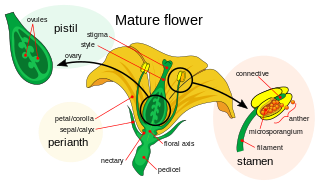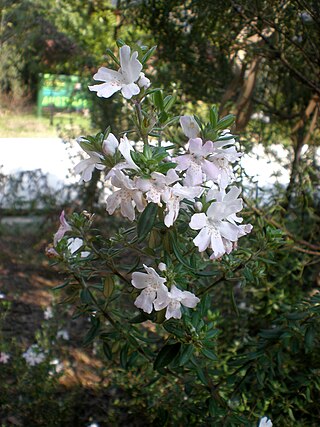Related Research Articles

In angiosperms, a hypanthium or floral cup is a structure where basal portions of the calyx, the corolla, and the stamens form a cup-shaped tube. It is sometimes called a floral tube, a term that is also used for corolla tube and calyx tube. It often contains the nectaries of the plant. It is present in many plant families, although varies in structural dimensions and appearance. This differentiation between the hypanthium in particular species is useful for identification. Some geometric forms are obconic shapes as in toyon, whereas some are saucer-shaped as in Mitella caulescens.

The stamen is a part consisting of the male reproductive organs of a flower. Collectively, the stamens form the androecium.

A sepal is a part of the flower of angiosperms. Usually green, sepals typically function as protection for the flower in bud, and often as support for the petals when in bloom.

Pinnation is the arrangement of feather-like or multi-divided features arising from both sides of a common axis. Pinnation occurs in biological morphology, in crystals, such as some forms of ice or metal crystals, and in patterns of erosion or stream beds.

Plant reproductive morphology is the study of the physical form and structure of those parts of plants directly or indirectly concerned with sexual reproduction.

In botany, a staminode is an often rudimentary, sterile or abortive stamen, which means that it does not produce pollen. Staminodes are frequently inconspicuous and stamen-like, usually occurring at the inner whorl of the flower, but are also sometimes long enough to protrude from the corolla.

The perianth is the non-reproductive part of the flower, and structure that forms an envelope surrounding the sexual organs, consisting of the calyx (sepals) and the corolla (petals) or tepals when called a perigone. The term perianth is derived from Greek περί and άνθος, while perigonium is derived from περί and γόνος . In the mosses and liverworts (Marchantiophyta), the perianth is the sterile tubelike tissue that surrounds the female reproductive structure.

Gynoecium is most commonly used as a collective term for the parts of a flower that produce ovules and ultimately develop into the fruit and seeds. The gynoecium is the innermost whorl of a flower; it consists of pistils and is typically surrounded by the pollen-producing reproductive organs, the stamens, collectively called the androecium. The gynoecium is often referred to as the "female" portion of the flower, although rather than directly producing female gametes, the gynoecium produces megaspores, each of which develops into a female gametophyte which then produces egg cells.

An ear is the grain-bearing tip part of the stem of a cereal plant, such as wheat or maize (corn). It can also refer to "a prominent lobe in some leaves."
Merosity refers to the number of component parts in a distinct whorl of a plant structure. The term is most commonly used in the context of a flower where it refers to the number of sepals in a whorl of the calyx, the number of petals in a whorl of the corolla, the number of stamens in a whorl of the androecium, or the number of carpels in a whorl of the gynoecium. The term may also be used to refer to the number of leaves in a leaf whorl.
This page provides a glossary of plant morphology. Botanists and other biologists who study plant morphology use a number of different terms to classify and identify plant organs and parts that can be observed using no more than a handheld magnifying lens. This page provides help in understanding the numerous other pages describing plants by their various taxa. The accompanying page—Plant morphology—provides an overview of the science of the external form of plants. There is also an alphabetical list: Glossary of botanical terms. In contrast, this page deals with botanical terms in a systematic manner, with some illustrations, and organized by plant anatomy and function in plant physiology.
This glossary of botanical terms is a list of definitions of terms and concepts relevant to botany and plants in general. Terms of plant morphology are included here as well as at the more specific Glossary of plant morphology and Glossary of leaf morphology. For other related terms, see Glossary of phytopathology, Glossary of lichen terms, and List of Latin and Greek words commonly used in systematic names.

Lepidobotryaceae is a family of plants in the order Celastrales. It contains only two species: Lepidobotrys staudtii and Ruptiliocarpon caracolito.

Adnation in angiosperms is the fusion of two or more whorls of a flower, e.g. stamens to petals". This is in contrast to connation, the fusion among a single whorl.

Connation in plants is the developmental fusion of organs of the same type, for example, petals to one another to form a tubular corolla. This is in contrast to adnation, the fusion of dissimilar organs. Such organs are described as connate or adnate, respectively. When like organs that are usually well separated are placed next to each other, but not actually connected, they are described as connivent.

In botany, a whorl or verticil is a whorled arrangement of leaves, sepals, petals, stamens, or carpels that radiate from a single point and surround or wrap around the stem or stalk. A leaf whorl consists of at least three elements; a pair of opposite leaves is not called a whorl.

A floral formula is a notation for representing the structure of particular types of flowers. Such notations use numbers, letters and various symbols to convey significant information in a compact form. They may represent the floral form of a particular species, or may be generalized to characterize higher taxa, usually giving ranges of numbers of organs. Floral formulae are one of the two ways of describing flower structure developed during the 19th century, the other being floral diagrams. The format of floral formulae differs according to the tastes of particular authors and periods, yet they tend to convey the same information.

Convolute as a verb literally means to "roll together" or "roll around", from the Latin convolvere. In general application the word can mean to "tangle" or "complicate", but in botanical descriptions convolute usually is an adjective from the Latin convolutus, meaning "rolled around". It commonly refers to a special class of imbricate structures — those where the overlapping edges of leaves, scales or similar elements are spirally wrapped, each scale having one edge within the previous scale and one outside the next scale. In the family Restionaceae the leaf sheaths commonly are convolute in this sense. However in structures such as a spathe, where there is only one element, a convolute element is spirally wrapped around itself or its branch. This is common in the buds of leaves and inflorescences of members of the family Araceae.

Westringia brevifolia Benth., commonly referred to as Greater Shortleaf Westringia is member of the Lamiaceae family, subfamily, Prosterantheroideae and one of four Westringia species native Tasmania, Australia. This evergreen shrub somewhat resembles rosemary and is similar in appearance to another Tasmanian species W. rigida, but can be distinguished by its shorter calyx lobes

In botany, floral morphology is the study of the diversity of forms and structures presented by the flower, which, by definition, is a branch of limited growth that bears the modified leaves responsible for reproduction and protection of the gametes, called floral pieces.
References
- ↑ Swartz, Delbert (1971). Collegiate Dictionary of Botany. New York: The Ronald Press Company. p. 136.
- ↑ Jackson, Benjamin Daydon (1928). A Glossary of Botanic Terms with their Derivation and Accent (fourth ed.). London: Gerald Duckworth & Co. Ltd. p. 174.
- ↑ Jackson, Benjamin Daydon (1928). A Glossary of Botanic Terms with their Derivation and Accent (fourth ed.). London: Gerald Duckworth & Co. Ltd. p. 271.
- Weberling, Focko; Pankhurst, R. J. (1992) Morphology of Flowers and Inflorescences, p. 11.